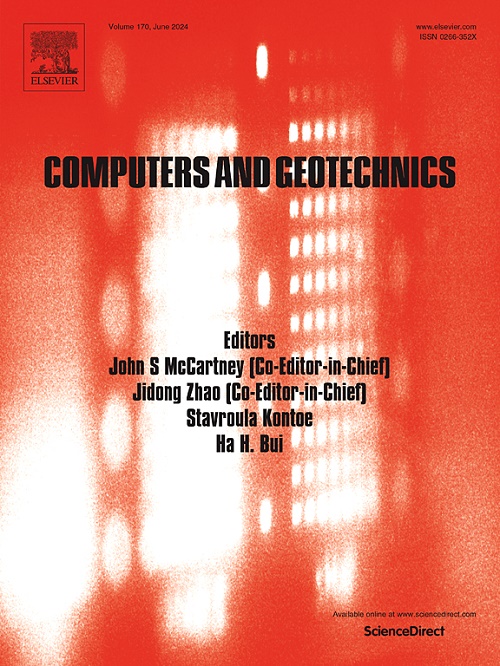粘土循环特性边界面模型及其在单桩海上风力机动力响应分析中的应用
IF 6.2
1区 工程技术
Q1 COMPUTER SCIENCE, INTERDISCIPLINARY APPLICATIONS
引用次数: 0
摘要
粘土的循环特性对海上风力发电机组的动力响应有重要影响。本研究提出了一种实用的边界面模型,能够同时描述循环安定和循环退化。该模型具有理论框架简单、参数数量有限的特点,并通过用户自定义材料(UMAT)子程序在ABAQUS中进行了数值实现。屈服面通过各向同性硬化保持原点的固定,同时引入一个可移动的投影中心来捕捉循环滞后行为。累积塑性偏应变被整合到塑性模量中来表示循环累积。对三种粘土进行不排水循环试验,验证了其再现应力-应变滞后、循环安定和循环退化的能力。通过对大直径单桩的离心试验,验证了该方法在求解有限元边值问题中的有效性。在此基础上,采用该模型分析了地震荷载作用下单桩桥的动力响应。结果表明:与循环安定相比,循环退化导致土体刚度逐渐降低,加速度放大减小,沉降积累增加,残余超孔隙压力增大,波动幅度增大;尽管有其优点,但该模型需要对塑性模量参数cd的符号进行先验规范,以捕获循环退化或稳定行为。此外,在不排水条件下,该模型导致有效应力路径的p-稳定化,从而导致超孔隙压力的低估。本文章由计算机程序翻译,如有差异,请以英文原文为准。
Bounding Surface Model for Cyclic Clay Behavior and Its Application in Dynamic Response Analysis of Monopile Offshore Wind Turbines
The cyclic behavior of clay significantly influences the dynamic response of offshore wind turbines (OWTs). This study presents a practical bounding surface model capable of describing both cyclic shakedown and cyclic degradation. The model is characterized by a simple theoretical framework and a limited number of parameters, and it has been numerically implemented in ABAQUS through a user-defined material (UMAT) subroutine. The yield surface remains fixed at the origin with isotropic hardening, while a movable projection center is introduced to capture cyclic hysteresis behavior. Cumulative plastic deviatoric strain is integrated into the plastic modulus to represent cyclic accumulation. Validation against undrained cyclic tests on three types of clay demonstrates its capability in reproducing stress–strain hysteresis, cyclic shakedown, and cyclic degradation. Additionally, its effectiveness in solving finite element boundary value problems is verified through centrifuge tests on large-diameter monopiles. Furthermore, the model is adopted to analyze the dynamic response of monopile OWTs under seismic loading. The results indicate that, compared to cyclic shakedown, cyclic degradation leads to a progressive reduction in soil stiffness, which diminishes acceleration amplification, increases settlement accumulation, and results in higher residual excess pore pressure with greater fluctuation. Despite its advantages, this model requires a priori specification of the sign of the plastic modulus parameter cd to capture either cyclic degradation or shakedown behavior. Furthermore, under undrained conditions, the model leads p-stabilization of the effective stress path, which subsequently results in underestimation of the excess pore pressure.
求助全文
通过发布文献求助,成功后即可免费获取论文全文。
去求助
来源期刊

Computers and Geotechnics
地学-地球科学综合
CiteScore
9.10
自引率
15.10%
发文量
438
审稿时长
45 days
期刊介绍:
The use of computers is firmly established in geotechnical engineering and continues to grow rapidly in both engineering practice and academe. The development of advanced numerical techniques and constitutive modeling, in conjunction with rapid developments in computer hardware, enables problems to be tackled that were unthinkable even a few years ago. Computers and Geotechnics provides an up-to-date reference for engineers and researchers engaged in computer aided analysis and research in geotechnical engineering. The journal is intended for an expeditious dissemination of advanced computer applications across a broad range of geotechnical topics. Contributions on advances in numerical algorithms, computer implementation of new constitutive models and probabilistic methods are especially encouraged.
 求助内容:
求助内容: 应助结果提醒方式:
应助结果提醒方式:


